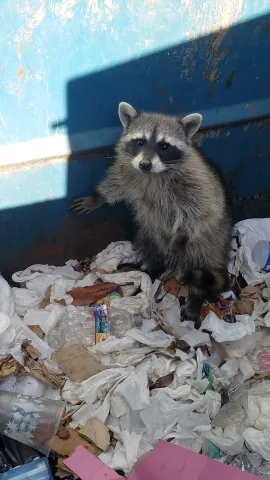Living with wildlife - May 2021
Mission Viejo Animal Services received a call from a concerned citizen regarding an animal that was stuck inside a large trash container behind her business, especially since trash hauler was on its way. When the Animal Services officer arrived at the scene, she spotted a raccoon. The animal looked healthy but was trapped. It had no way of getting out. The officer placed poles inside the bin to see if the raccoon will climb out, but it was too scared. Using a catch all, the officer looped it around the raccoon's belly under the arms and lifted it out of the bin. She then released the animal, which ran straight for a tree. It climbed the tree easily and was safe and sound.
Raccoons are sometimes called trash pandas since they like to scavenge in trash bins for food. They need to hunt for food to survive, and the easiest place to find food is in a trash bin or our backyards. This makes human neighbors the best neighbors! Unfortunately, many people do not see raccoons the same way. Raccoons are considered a nuisance and are misunderstood by many so they are trapped and killed. Raccoons used to live in holes in trees and caves. They scavenged and sometimes hunted for food. With the destruction of their homes and land to build human homes, raccoons like many other animals, had to adapt. They now live in sewers, chimneys, attics, walls, and even crawl spaces. They have food easily accessible from trash bins, pet food that is left outside, gardens, and bird feeders among other things. They enjoy warm swims in people's jacuzzies and love to play in the backyards. There are different things people can humanely do to deter them from our properties such as making sure you don't leave food outside and that your trash bins are closed properly.
For more tips on keeping racoons at bay, visit
https://www.humanesociety.org/resources/what-do-about-raccoons.

